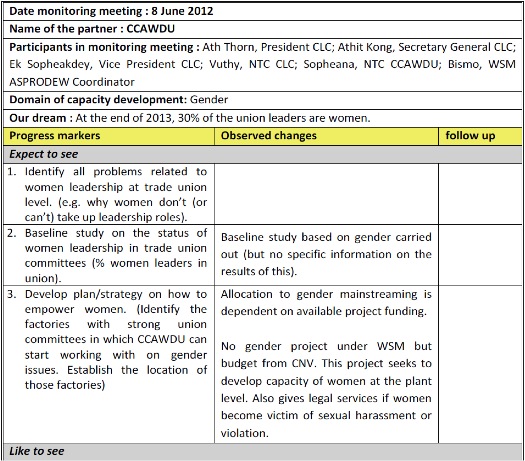Outcome Mapping Practitioner Guide
Using the progress markers as a guide for dialogue during monitoring meetings
Using the progress markers as a guide for dialogue during monitoring meetings instead of a checklist can help to energise and sustain the monitoring process over time
Author: Jan Van Ongevalle
Published: Sunday 21 September 2014
After an initial monitoring and evaluation planning workshop based on elements of outcome mapping in June 2011 with Cambodian partner organisations, it was discovered by World Solidarity that no monitoring had been done for more than half a year after the workshop. This was partly due to changes in staff within World Solidarity during that time. When the World Solidarity coordinator called for a monitoring meeting in April 2012, it became clear that partner organizations had as good as forgotten about the M&E system for capacity development. They couldn’t even recall their vision statements or their progress markers which they had developed to monitor progress around capcity development and no monitoring had been done.
Eventually a first monitoring meeting was organized in June 2012 involving staff from the partner organisations and the World Solidarity coordinator. The progress markers were used as a basis for dialogue and reflection during the meeting. Interestingly, the progress maker monitoring tool helped to provide focus but at the same time, the conversation didn’t strictly follow the progress markers only. Participants of the meeting discussed those issues that they found important and relevant in relation to their capacity development process. Hence information about the progress markers as well as useful information not linked to specific progress markers emerged. The figure below shows an extract from the progress markers monitoring tool that was completed during the monitoring meeting with one of the Cambodian partner organisations.

This nugget was applied in: World Solidarity Capacity Development programme (Latin America, Africa, Asia), 2010-2016.
Related Practitioner Guide sections:



